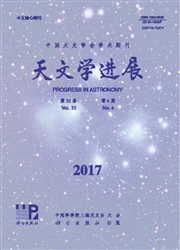

 中文摘要:
中文摘要:
一般认为超新星遗迹是银河系内高能宇宙线粒子的主要源,粒子(轻子和强子)在超新星遗迹中通过扩散激波加速机制被加速到极相对论性能量。近年来,越来越多的观测特别是X射线和1射线波段的观测支持了这一观点。阐述了超新星遗迹多波段非热辐射的含时模型的研究情况,并将模型应用于4颗超新星遗迹G347.3—0.5,G266.2—1.2,G8.7—0.1和G23.3—0.3,结果显示模型可以很好地解释这4颗SNRs的多波段观测。
 英文摘要:
英文摘要:
Supernova remnants (SNRs) are usually thought to be the prime candidates of the origin of cosmic rays in the Galaxy. Increasing observational evidences especially in X-rays and γ-rays during the course of the last few years support the notion that SNRs are important cosmicray sources in the Galaxy. Recently, more and more very high-energy (VHE) γ-rays from SNRs have been detected with ground-based TeV γ-ray telescopes, such as HEGRA, HESS, CANGAROO and MAGIC. Theoretically, those TeV γ-rays can be produced either via inverse Compton scattering of soft photons by relativistic electrons or through proton-proton (p-p) interaction as high-energy protons collide with the ambient matter in an SNR. Moreover, it is not clear whether the TeV photons form SNRs have electronic origin or hadronic origin now. Particles (hadrons and leptons) are generally accelerated to extremely relativistic energies through diffusive shock (also called first order Fermi) acceleration mechanism. The paper reviewed the time-dependent model describing multi-waveband emission from SNRs. In the model, the non-thermal electron, proton spectra, and then multi-wavelength spectra produced by synchrotron radiation, bremsstrahlung radiation, inverse Compton scattering for leptons( electrons and positrons) and p-p interaction for protons, respectively can be calculated at different ages of a supernova remnant. The shell-type SNR G347.3-0.5 (RX J1713.7-3946) is a core collapse supernova exploded in A.D. 393 at a distance of about 1 kpc. The SNR has been observed in radio, X-ray and γ-ray band detailedly. The results show that the non-thermal emission from radio to hard X-ray band is predominately produced via the synchrotron radiation of the electrons, whereas the observed TeV γ-rays are mainly from the p-p collisions between the accelerated protons and the ambient matter. The SNR G266.2-1.2 (RX J0852.0-4622) was discovered based on the X-ray data from the ROSAT All-sky survey. VHE γ-rays from the SNR have b
 同期刊论文项目
同期刊论文项目
 同项目期刊论文
同项目期刊论文
 期刊信息
期刊信息
